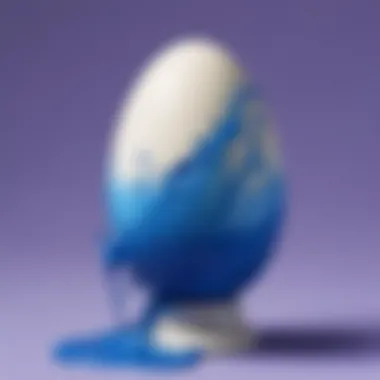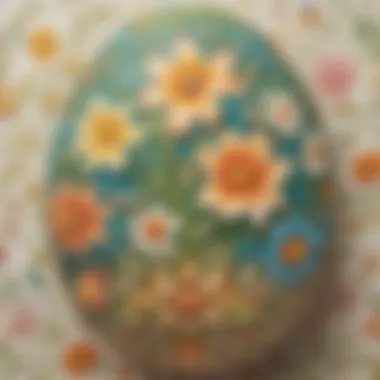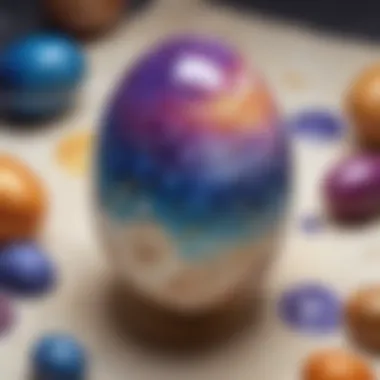Unleashing Creativity: Enhancing Easter Eggs with Food Coloring and Vinegar


Science Fun Facts
Did you know that food coloring and vinegar can be used to create beautifully dyed Easter eggs? These common kitchen ingredients can transform plain eggs into colorful works of art, perfect for the Easter celebration!
Discover the Wonders of Science
By combining food coloring with vinegar, you embark on an exciting scientific journey of color mixing and absorption. The acidity of the vinegar helps the eggshells to attract and hold the vibrant hues, resulting in stunning visual outcomes that captivate the eye and spark creativity.
Science Experiment Showcase
In this fun and educational experiment, children and adults alike can explore the chemical reactions between food coloring, vinegar, and eggshells. Step-by-step instructions will guide you through the process, ensuring a safe and engaging experience. Remember to gather all materials beforehand, including white vinegar, food coloring in assorted shades, boiled eggs, and containers for dyeing.
Materials List:
- White vinegar
- Food coloring (assorted colors)
- Boiled eggs
- Containers
Safety Tips and Precautions
- Adult supervision is recommended, especially when handling boiling water.
- Be cautious when working with glass containers and vinegar to prevent accidents.
- Set up a designated work area to avoid spills and messes.
Dive into this enthralling experiment and witness the magic of food coloring and vinegar come to life on your Easter eggs! Unleash your inner artist and create vibrant masterpieces that will amaze and delight all who behold them.
Introduction
In the realm of Easter celebrations, the art of dyeing eggs holds a special place, symbolizing new life and colorful beginnings. The use of food coloring and vinegar to enhance this tradition brings a modern twist to an age-old practice. This article will navigate through the intricate process of using these household items to elevate simple eggs into works of art. By exploring the synergy between food coloring and vinegar, individuals can unlock a world of creativity and self-expression, making Easter even more vibrant and engaging.
Understanding the Basics of Easter Egg Dyeing


When delving into the realm of Easter egg dyeing, it is imperative to grasp the fundamental concepts that underpin this creative activity. From selecting the ideal eggs to understanding the varying dyeing techniques, each step contributes to the final masterpiece. Familiarizing oneself with the basics sets a strong foundation for a successful dyeing experience, ensuring that each egg turns out beautifully and artistically captivating.
Benefits of Using Food Coloring and Vinegar
The utilization of food coloring and vinegar in the dyeing process offers a plethora of advantages that elevate the overall outcome of decorated eggs. Food coloring provides a vast spectrum of hues, allowing for endless color combinations and artistic possibilities. On the other hand, vinegar acts as a crucial agent that helps set the dye, ensuring long-lasting and vibrant results. Together, these ingredients work harmoniously to create stunning and visually appealing Easter eggs that are bound to impress both creators and observers alike.
Overview of the Dyeing Process
Navigating through the dyeing process involves a series of meticulous steps that culminate in beautifully colored eggs. From preparing the dye solution to submerging the eggs, each stage demands careful attention and precision. Understanding the sequence of actions and techniques involved in dyeing eggs enables individuals to achieve consistent and striking results. By delving into the intricacies of this process, creators can enhance their skills and produce Easter eggs that serve as delightful centerpieces during the festive season.
Getting Started: Materials Needed
When embarking on the exciting journey of dyeing Easter eggs using food coloring and vinegar, the initial step is crucial - gathering the necessary supplies. Selecting the appropriate materials ensures a smoother and more enjoyable experience for both children and adults alike. By paying attention to the tools and ingredients required, you pave the way for a successful egg-dyeing session.
List of Required Supplies
To properly prepare for the egg-dyeing process, it is essential to have the following items on hand:
- Hard-boiled eggs: The foundation of this creative endeavor, providing a canvas for the vibrant colors.
- Food coloring: Opt for liquid food coloring in a variety of shades to achieve a spectrum of colors.
- White vinegar: This household staple not only intensifies the hues but also aids in setting the dye onto the eggs.
- Bowls or cups: Ensure you have containers deep enough to fully submerge the eggs in the dye.
- Spoon or tongs: To safely handle the eggs during the dyeing process.
- Paper towels or cloth: For drying off the eggs and cleaning up any spills or messes. Make sure to lay out all these supplies in a convenient and organized manner before beginning the activity to facilitate a seamless and enjoyable egg-dyeing experience.
Preparation Steps
Once the materials are assembled, it's time to prepare for the creative process of coloring the Easter eggs. The initial steps involve:
- Setting up the workspace: Choose a well-lit and spacious area to work in, covering surfaces with newspaper or a protective material to prevent staining.
- Protecting clothing: Consider wearing aprons or old clothes to avoid any accidental spills or splatters during the dyeing process.
- Organizing the stations: Designate specific areas for different tasks, such as dye preparation, egg dipping, and drying, to streamline the process. By following these preparation steps diligently, you lay the foundation for a successful and enjoyable egg-dyeing session with food coloring and vinegar.
Creating the Dye Solution


Creating a vibrant and effective dye solution is a crucial step in the process of dyeing Easter eggs with food coloring and vinegar. This section will provide detailed insights into the significance of this process and how it impacts the overall outcome of your dyed eggs.
Mixing Food Coloring and Vinegar
Mixing food coloring and vinegar is a fundamental aspect of creating the dye solution for Easter eggs. The acidity of vinegar helps the color adhere to the eggshells, resulting in brighter and more saturated hues. In this section, we will delve into the proper ratios and techniques required to achieve the desired color potency.
Adjusting Color Intensity
Adjusting the intensity of the dye solution allows for greater control over the final color outcome on your Easter eggs. By understanding how to tweak the proportions of food coloring and vinegar, you can achieve a spectrum of shades ranging from pastel to deep and rich tones. This segment will explore the various methods and tricks to modify color intensity effectively.
Dyeing Your Easter Eggs
In the realm of Easter egg decoration, dyeing your eggs holds paramount importance. This section explores the core of the creative process, where mundane eggshells are poised for a colorful metamorphosis. By immersing the eggs in a dye solution, a magical alchemy occurs, turning them into vibrant canvases ready to showcase a spectrum of hues. The use of food coloring and vinegar in this process not only infuses the eggs with vibrant colors but also ensures a safe and edible end product. Dyeing eggs is not just a tradition; it is an art form that encourages experimentation and creativity, making the Easter celebration more engaging and memorable.
Submerging the Eggs in the Dye Solution
To achieve the perfect color saturation and uniformity, the method of submerging eggs in the dye solution plays a crucial role in Easter egg dyeing. This step involves gently placing the eggs into a mixture of food coloring and vinegar, allowing them to absorb the rich pigments slowly. Proper submersion ensures that the color coats the entire egg surface evenly, resulting in vibrant and visually appealing hues. The duration of submerging varies depending on the desired intensity of color, with longer soaking times resulting in deeper shades. This meticulous process guarantees that each egg emerges as a unique masterpiece, reflecting the creativity and precision of the dyer.
Tips for Achieving Different Color Effects
Unlocking a diverse range of color effects on Easter eggs requires a strategic approach and a touch of creativity. By tweaking factors such as dye concentration, soaking duration, and vinegar ratio, various color effects can be achieved. For pastel shades, diluting the dye solution with water creates soft, translucent colors, perfect for a delicate aesthetic. Conversely, increasing the dye intensity and vinegar content produces more intense and vivid hues, adding a bold and striking flair to the eggs. Experimenting with different techniques, such as layering colors or creating ombre effects, opens up a world of possibilities for personalized and eye-catching designs.
Adding Patterns and Designs
Elevating Easter egg decoration to a higher level, incorporating patterns and designs injects an extra dose of creativity and craftsmanship. From simple geometric shapes to intricate floral motifs, the application of patterns adds depth and visual interest to dyed eggs. Techniques like using wax to create resist patterns or employing stencils for precise detailing offer endless opportunities for customization. Whether drawing freehand or using creative tools, adding patterns and designs allows for a personalized touch, making each egg a unique reflection of artistic ingenuity and attention to detail.
Enhancing Your Easter Eggs


In the realm of Easter egg decoration, enhancing your creations serves as a pivotal stage that elevates the visual appeal and artistic charm of the eggs. Enhancing techniques involve adding supplementary elements to the dyed eggs, transforming them from mere colored entities into engaging works of art that command attention. By focusing on enhancing your Easter eggs, you imbue them with a unique aesthetic value that sets them apart from ordinary dyed eggs.
Enhancing plays a vital role in personalizing your Easter eggs, allowing you to express your creativity and individuality through various artistic interventions. Whether it's incorporating shimmering effects, intricate designs, or additional textures, enhancing your Easter eggs offers a canvas for experimentation and innovation. These techniques enable you to explore different aspects of visual appeal and crafting, making the Easter egg decoration process more enriching and rewarding.
Embracing the concept of enhancing your Easter eggs opens a world of possibilities in terms of creativity and design. Through utilizing techniques like creating shimmering effects with vinegar and adding final touches with sealant options, you can imbue your eggs with a distinctive and polished finish that reflects your attention to detail and artistic sensibility. Indeed, enhancing your Easter eggs transcends the realm of simple dyeing, evolving into a transformative artistic endeavor that showcases your crafting skills and decorative flair.
Shimmering Effects with Vinegar
Shimmering effects with vinegar represent a captivating technique to elevate the visual allure of your Easter eggs. By introducing vinegar into the dye solution, you create a chemical reaction that results in a mesmerizing shimmer on the eggshell, imbuing it with a subtle yet enchanting luminosity. This process enhances the overall aesthetic appeal of the eggs, adding depth and dimension to their appearance.
The shimmering effects achieved through vinegar infusion lend a touch of sophistication to your Easter eggs, making them stand out as unique and visually compelling decorative pieces. The reflective quality brought about by the vinegar adds a whimsical charm to the eggs, captivating the onlooker with its luminous sheen. This technique is particularly effective for creating an elegant and refined look, perfect for showcasing your artistic prowess during the Easter festivities.
Final Touches and Sealant Options
Upon completing the dyeing and enhancing process, applying final touches and sealant options ensures the longevity and preservation of your decorated Easter eggs. Final touches may involve embellishments such as glitter, metallic accents, or even intricate hand-painted designs, adding a personalized and luxurious touch to the eggs. Sealant options, including clear varnish or wax, create a protective layer that seals in the colors and enhancements, safeguarding the eggs from damage and ensuring their durability.
Incorporating final touches and sealant options not only enhances the aesthetic appeal of your Easter eggs but also contributes to their longevity and endurance. By conscientiously applying sealants and finishing touches, you safeguard your creative efforts and ensure that your decorative Easter eggs retain their beauty for an extended period. This meticulous attention to detail guarantees that your artistic endeavors endure beyond the Easter season, allowing you to showcase your craft and creativity throughout the year.
Presentation and Enjoyment
When it comes to Easter egg decorating using food coloring and vinegar, the culmination of the entire process lies in the crucial aspect of Presentation and Enjoyment. The final steps involving how you display your colorful creations can significantly impact the overall aesthetic and enjoyment of the Easter eggs. In this section, we will delve into the importance of effectively showcasing your dyed eggs and explore various methods to maximize the visual appeal. Additionally, we will discuss the intrinsic joy that comes from presenting your creations to friends and family, adding a sense of fulfillment to the artistic process.
Displaying Your Colorful Creations
Once you have successfully dyed your Easter eggs using food coloring and vinegar, the next step is to focus on Displaying Your Colorful Creations. This phase allows you to showcase your artistic skills and creativity through various presentation techniques. From arranging the eggs in a decorative basket to using them as table centerpieces, the possibilities are endless. We will explore different ways to display your dyed eggs, highlighting how each method can enhance the visual impact and contribute to a vibrant Easter ambiance.
Creative Ways to Use Dyed Eggs
Beyond the traditional act of dyeing eggs for Easter, there are numerous Creative Ways to Use Dyed Eggs that add an element of fun and innovation to the holiday celebrations. From incorporating dyed eggs into arts and crafts projects to using them as unique decorations, this section will inspire you to think outside the box. We will discuss imaginative ways to repurpose dyed eggs, encouraging experimentation and creativity among children and adults alike.
Safety Tips and Proper Egg Handling
As we indulge in the excitement of Easter egg dyeing using food coloring and vinegar, it is essential to prioritize Safety Tips and Proper Egg Handling to ensure a safe and enjoyable experience. This section will provide valuable insights into best practices for handling dyed eggs, including guidance on storage, consumption, and disposal. By understanding the importance of proper egg handling, you can fully appreciate the artistic process while mitigating any potential risks or concerns.







